Malcolm and Tracy in
Verona and Venice, November 1999
Saturday 30/10/99. To Italy.
| Flight BA0588 touched down in Marco Polo airport, Venice after a
short but comfortable flight including a champagne brunch. Accommodation
in Venice over the 'All Saints Day' weekend was non-existent so we hopped on the train to
Verona. This turned out to be marvellous value at 10,400L (about £3.30) each for a one
way ride of 1.5 hours and 65 miles.
The map we picked up at Verona train station showed our hotel not
too far away so we decided to walk. Once we passed through the city walls, Verona turned
out to have the same rustic appearance of many Italian towns with plastered brickwork
painted in warm pastel colours and crumbling slightly at the edges.
The city seemed to be centred around a brown brick built castle
situated by the river looking much like the one in the centre of Milan. Our hotel was
right by this but difficult to get to because they were re-cobbling the street outside.
They also made it more difficult to find by giving the only indication that it was a hotel
by its name on the mat outside. No wonder they had a vacancy where no other hotel did.
Still, inside it was nice.
The river was fast flowing as if swelled by recent rain. As we
walked along the embankment, bats darted past the trees in autumn leaf.
In one of many piazzas we met some spooks that turned out to be
young children under bed sheets (Halloween stems from All Saints Day!).
We ate pizza and pasta with a distinct smoked salmon theme washed
down with Valpolacella of the table variety. |
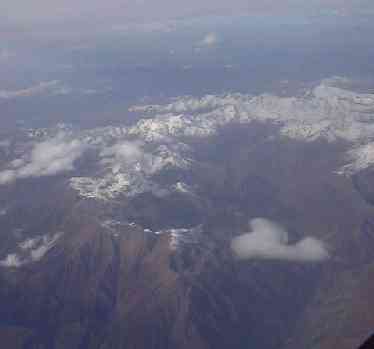
Over the Alps

Coming in to land at Marco Polo airport.
|
Sunday 31/10/99. Verona.
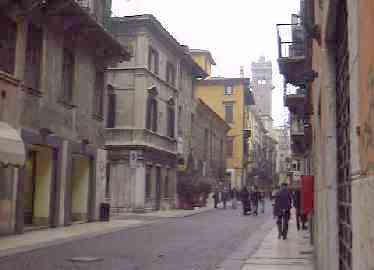
Corso Porta Borsari, leading from the Porta (town gate) Borsari.
|
The local marble 'Rosa Verona', that attracted us to the city,
features everywhere. Shop-fronts, columns, pavements and even the amphitheatre are made of
the pink/red/brown stone. |
| Cars are thankfully scarce but the streets throng with people
especially around the market. Some of the buildings around the market (piazza delle Erbe)
were elaborately painted with frescoes and decoration to make the buildings look more
impressive than they really are. Since painted, they have been carefully neglected to
create that rustic appearance. |
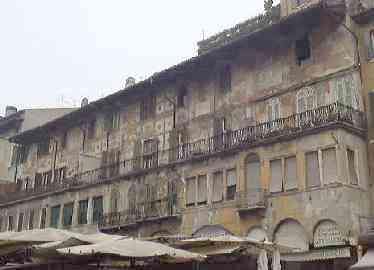
Piazza delle Erbe (market square).
|
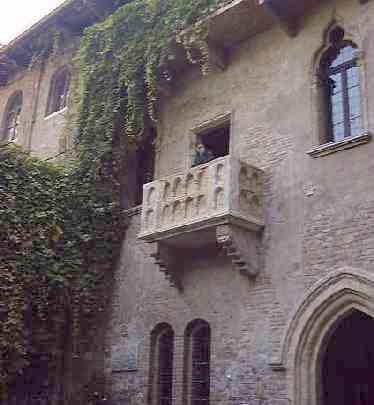
Juliet's balcony.
|
There are many impressive public buildings of stone featuring
pillars and statues. One limestone faced building had what looked like square based
pyramids stuck all over the outside giving it a spiky appearance. Juliet's house proved to be a popular attraction with frequent camera
flashes lighting up the world famous balcony. It is curios to think that the English
playwright Shakespeare provided that balcony with its fame. |
| The amphitheatre (arena) is styled much like the Coliseum in
Rome except smaller, oval and more complete. The castle is
also in a good state if repair with drawbridge and portcullis intact. It includes a grand
fortified bridge over the river 'Fiume Adige'. |
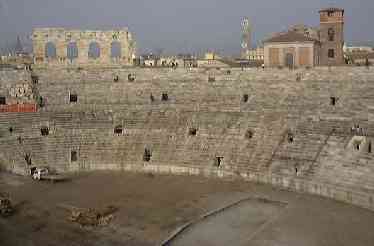
Amphitheatre "Arena".
|
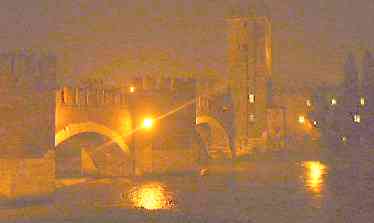
View of the castle and bridge at night
|
A gentle stroll along the banks of the river concluded our first
day in Verona. At night the centre came alive with couples
promenading over the bridge by the castle and along the main streets. |
Monday 1/11/99. Verona in the sun.
| The sun came out at midday and the temperature quickly rose to
21C. It is a bank holiday here and many other people walked with us along the banks of the
river. |
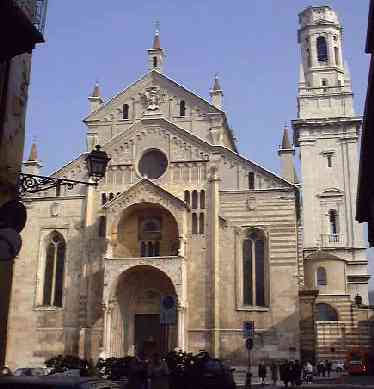
The cathedral
|
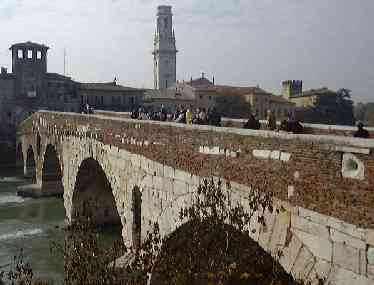
Ponte Pietra, The Roman stone bridge.
|
We stopped off to visit the cathedral, Roman stone bridge and
theatre in-between coffee breaks. |
| The view from above the theatre across the city was impressive
if a little hazy. |
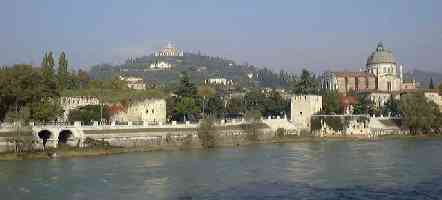
View north over the Fiume (River) Adige to the St. Giorgio in Braida (right)
|
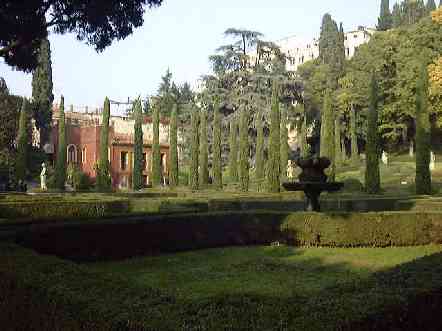 |
To the south and east of the river is Giusti Gardens (8000L)
which turned out to be a classic Italian garden with low privet hedges laid out in the
style of a maze with flower beds, |
| statues and fountains in between. Being November there were no
flower blossoms but we enjoyed walking round in the warm sunshine. In the evening we went out to eat but got only as far as the hotel
restaurant, which looked rather inviting. This proved to be a good choice because not only
was the food excellent but we were the only customers at that time and the waiter helped
us immensely with the menu. Later on a family birthday party arrived and we were amazed at
how much food they all put away. |
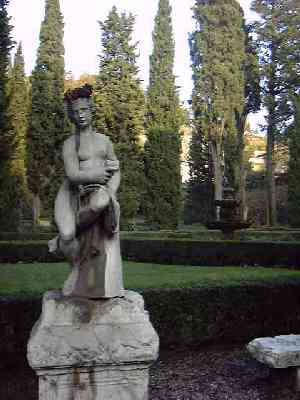 |
Tuesday 2/11/99. Tracy’s birthday.
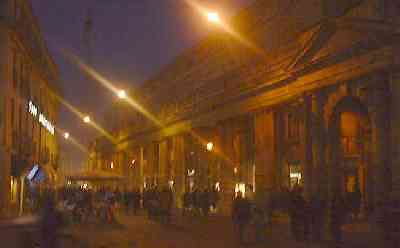
Via Roma at night.
|
We stopped for breakfast of croissant and coffee at our
favourite cafe in Via Roma before walking to the train station. It was a cloudy day, which
made it easier to leave this beautiful, gentle, and relaxing city. The absence of cars
that made the place so favourable to us has changed as the residents return to work. The ticket machine in the station speaks 6 languages but we have trouble
believing that we have almost a two-hour wait till the next train to Venice. Having
purchased our tickets for 17,000L each we trek back into town to find a nice coffee shop.
The train is 25 minutes late, much like home really. Finally we
ride out of Verona through a sea of vineyards towards our next destination. |
| The causeway now links Venice to the mainland so the train pulls
right into Saint Lucia station on the 'island'. The station leads out to the Canal Grande
but instead of busses waiting to take us too our hotel there are boats. Being hiking types
we elect to walk to our hotel to drop off our bags. The map we picked up from the tourist
information gives a layout of paths but precious few names. it takes a while to work out
just how large the scale actually is. The whole place seems to be a labyrinth of shops
interconnected by narrow alleyways. It is a bit like playing a game of snakes and ladders
trying to get from A to B with the bridges acting like ladders to assist you and the
canals as snakes impeding your progress. |
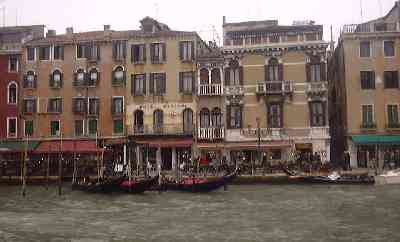
Canal Grande (Grand Canal)
|
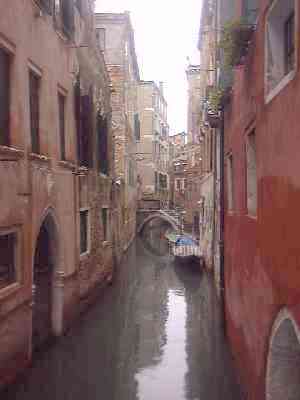 |
After numerous detours and 2 hours we make it to our hotel only
1.5Km from the train station. The hotel (Casa Verardo.
180,000L prpn) room and staff turn out to be very nice and we anticipate a good stay. |
| So far, Venice appears to be a shopping mall island with a focus
not just in cloths but party masks! They are everywhere, little shops, big shops, market
stalls, everywhere you look, papier mâché painted masks are peering at you. As our guide suggests, the quality of the food is inversely proportional
to the number of tourists and our first meal turns out to be of the highest price but
lowest value. This is not what we have come to expect from Italy! |
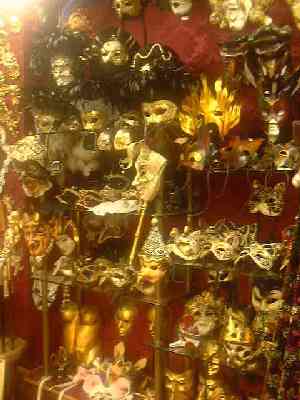
A shop display of Carnival masks.
|
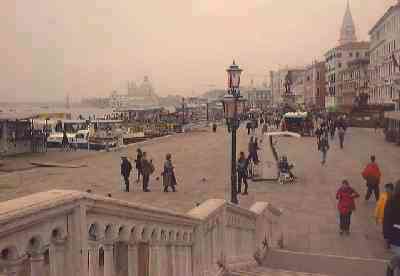
Riva Ca di Dio. The banks of the Canal di St. Marco
|
An evening stroll along the southern shoreline eastwards from
Piazza Saint Marco proves to be most pleasing. |
| There is even a square-rigged barque sailing ship moored by the
quay to complete the scene. |
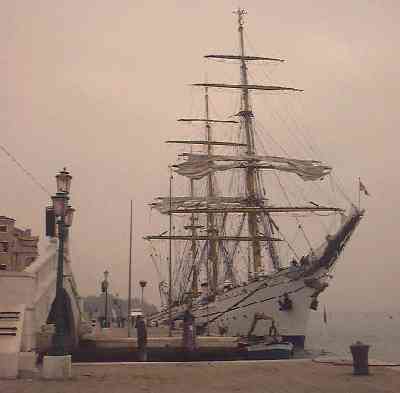
The 'Gork Foch' barque sailing ship moored in the Canale de St. Marco.
|
Wednesday 3/11/99. The quiet side of Venice.
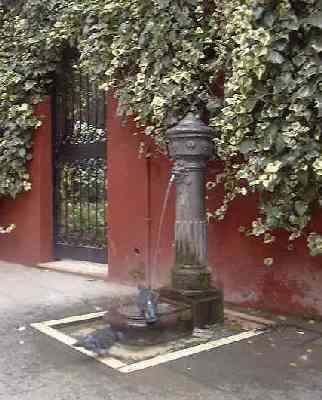
Pigeons in a drinking fountain in Via Garibaldi.
|
Away from the hustle bustle in the tourist centre today and back
out eastward along the southern shoreline. From here we can see the other islands of La
Giudecca across the Canale Della Giudecca. This canal is more like a sea channel with
large ferries and huge sailing ships. Up this end of the island there are few tourists and
even some parks. Greenery is scarce in the packed real estate of the central city. |
| Eventually we find ourselves at the most eastern tip of the
island in amongst the military establishment and the sports stadium. This end of the
island seems to be more residential. |
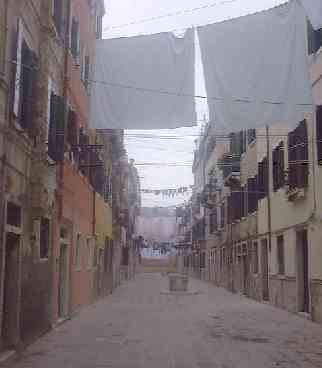
A residential street.
|
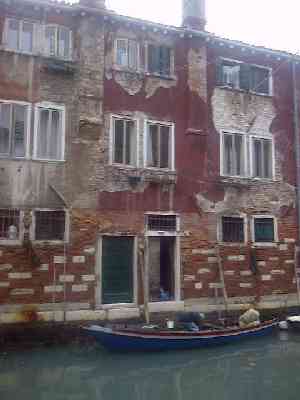
Boat moored by a residence in Fonoamenta si anna.
|
Despite the throngs of people in the tiny warren like alleyways
of the city centre the place seems to have a sereneness about it, perhaps afforded by the
absence of roads and cars. There are hardly any boats traversing the little canals as most
people travel on foot. The temperature in November is cool
but comfortable. Occasionally we notice a waft of, shall we say 'stagnant water' from the
canals but it is not overpowering.
Not wishing for a repeat of last nights substandard supper, we
pick up a bottles of wine and Grappa from a grocery store and a couple of tasty pies from
a bakery. These make an excellent meal and costs less than a quarter of the price of last
nights meal. |
| The evening is rounded off perfectly by an outing to hear a
concert of Vivaldi, Bach, Albinoni, Mozart and other composers played by the 'Orchestra di
Venezia' at the 'Scoula Grande, Saint Giovanni Evangelista'. |
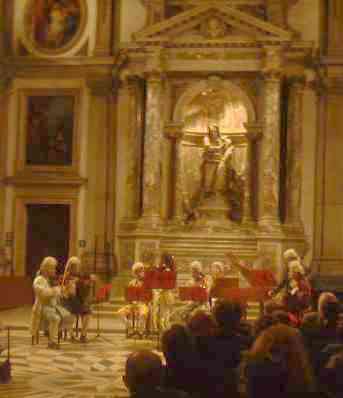
Vivaldi concert at St. Giovanni Evangelista.
|
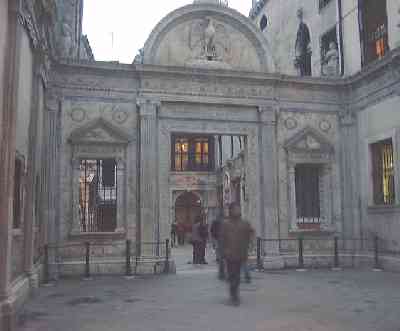
Outside St. Giovanni Evangelista.
|
Fortunately the concert hall is only a half-hour walk from our
accommodation if either you know where you are going or you walk fast. We finish the
evening of nicely with the Grappa. |
Thursday 4/11/99. Glass island.
We took a little ferryboat round to the nearby island of Murano
where the glass manufacturing industry of Venice was banished due to the fire risks from
the furnaces. It is thought that the glass industry started in Venice in about the 8 or
9th century after the fall of the Roman empire. Many of the Roman glass blowing techniques
were retained and improved upon until Murano glass was one of the best in the world.
Changing government taxes put paid to that by forcing the glass blowers to take their
skills and secrets overseas where taxes were lower.
Today the techniques are common all over the world and the fancy
glassworks of Murano seem nothing special. That does not stop the locals from trying to
fog the stuff and 90% of the shops we passed were crammed full of colourful glass
trinkets. Many of them looked pretty under the display lights but you would not want to
take them home. We managed to see the museum, which was interesting apart from looking
rather like the shops just without the price tags. We would have liked to see the glass
blowers at work but they all seemed to have stopped for the day by the time we got there.
Still, the boat trip was nice.
Murano appeared much like Venice with canals, bridges and
crumbling houses. Some weathered looking bricks outside the museum crumbled to dust under
our touch so we moved on quickly. The atmosphere is different with more working folk and a
more rural feeling.
Friday 5/11/99. Lace land.
| We tried to visit a glass blowing furnace in Venice but again it
was closed so we set off for Burano, another little island where traditionally the men
folk go fishing and the women folk make lace. This island
is pleasantly unpopulated and less frequented by tourists. The first thing you notice is
the brightly coloured houses. Apparently there used to be a meaning to the colour of a
house but the meaning has been forgotten and now everyone paints their house whatever
colour they choose. Also noticeable is how uncharacteristically well kept all the houses
are. Most all are neatly plastered and painted. The streets are wide and clean and the
canals all parked up with boats. |
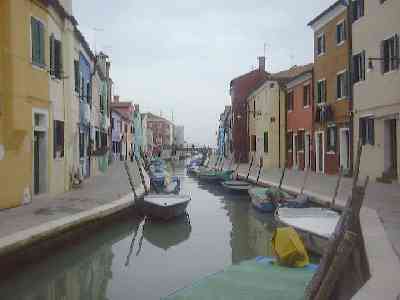
The main street in Burano.
|
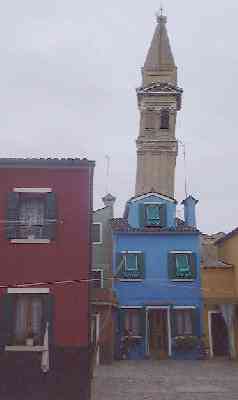
The 'Leaning tower of Burano'
|
The museum showed how the women used to produce the lace in
production line fashion with each doing a different stitch. Exhibits showed how the
pattern was drawn onto paper then the cotton stitched on with a needle. Nowadays most all
of it is made by machine and imported to the island. A
tasty lunch followed with dishes of lasagne and squid all washed down by a couple of
glasses of rose wine and followed by ice creams. |
Wooden posts, some with lights, mark deep-water channels through
the shallow waters between the islands and our water-bus wove its way through the
picturesque scene in the fading light back to Venice.
Our time in Venice is up but we have enjoyed our stay immensely.
The combination of tiny passages interwove with canals and between historic buildings
opening into tiny piazzas crammed with stalls packed with glitzy things must be unique in
the world. All this has been preserved as a tourist resort for shopping, eating and all
things leisurely.
Travelogues by Malcolm Weller 
Back
to the index of Mal's travelogues

























